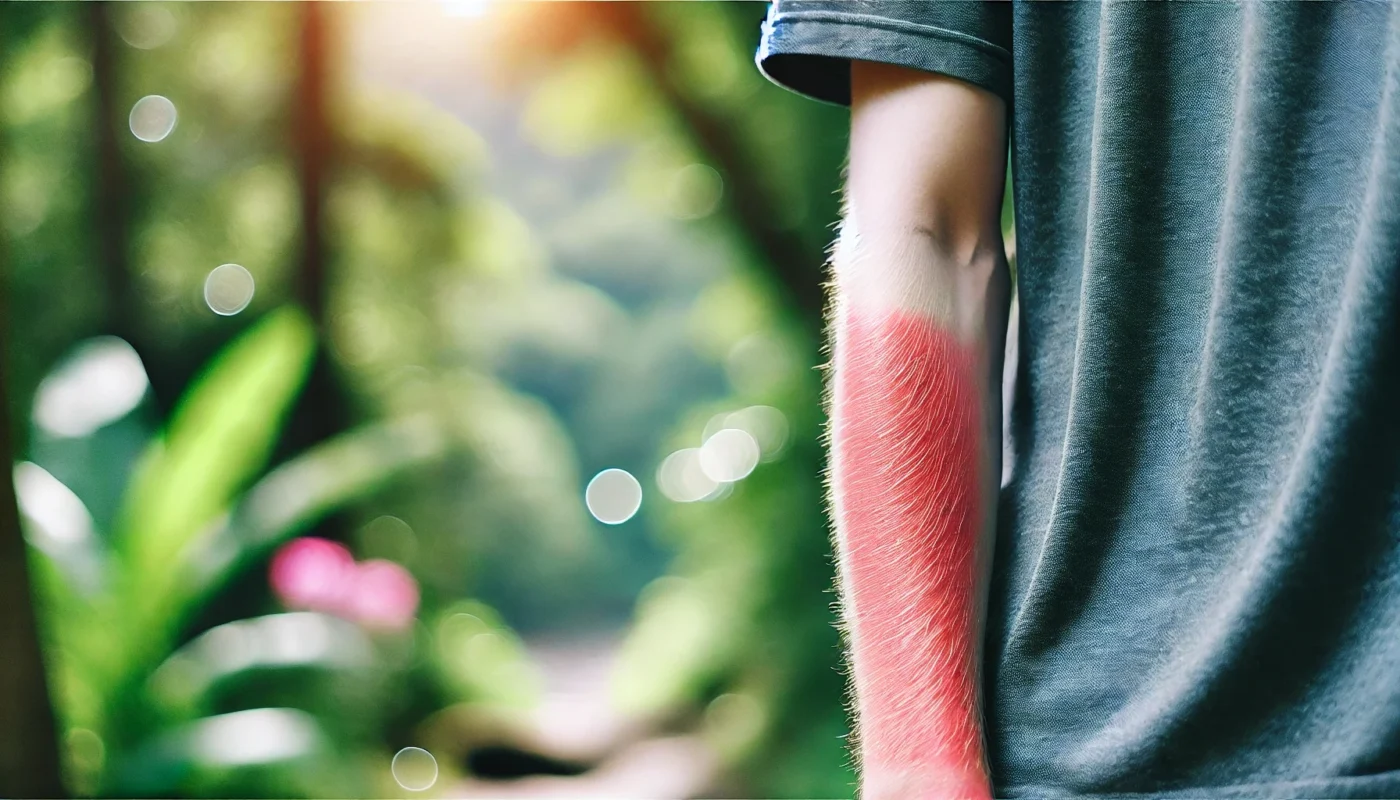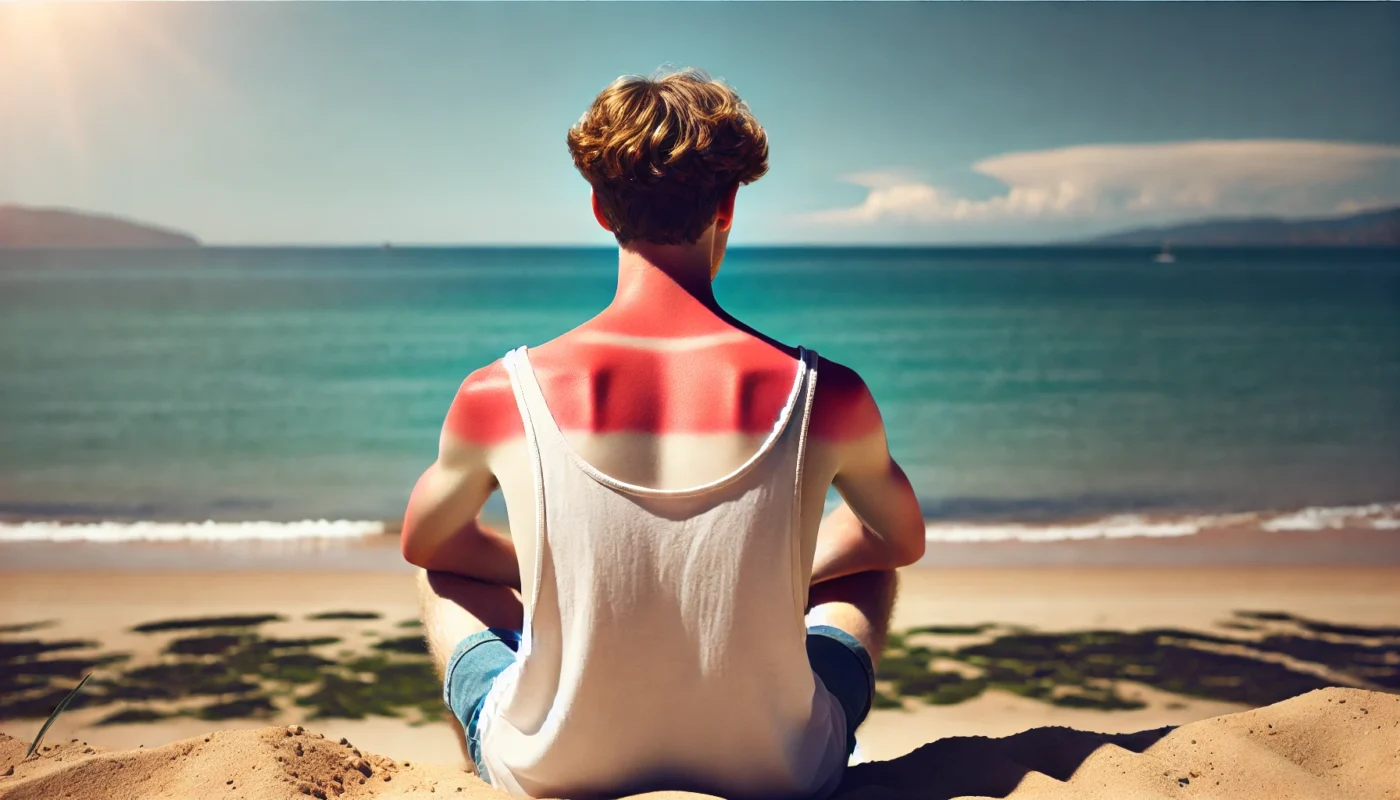Sunburn is a prevalent issue that can impact anyone, but it poses a significant risk for individuals with fair skin. This skin type, characterized by lower melanin levels, is particularly vulnerable to the detrimental effects of ultraviolet (UV) radiation. This article will explore why fair-skinned individuals are more prone to sunburn, delve into the biological mechanisms of sunburn, and provide practical strategies for effective skin protection.
You may also like: Essential Tips for Sun Protection Daily
The Science of Sunburn
Sunburn is more than just a temporary discomfort; it is a complex biological reaction to UV radiation exposure. The damage caused by UV rays can have both immediate and long-lasting effects on the skin.
The Mechanism of Sunburn
Sunburn occurs when the skin’s exposure to UV radiation surpasses its ability to protect itself with melanin. UV rays penetrate the skin layers, causing cellular damage. This damage triggers the body’s inflammatory response, resulting in the redness, swelling, and pain typically associated with sunburn. The severity of sunburn can vary based on exposure time, UV index, and individual skin characteristics.
Types of UV Radiation
Understanding the types of UV radiation can help in comprehending sunburn’s impact. UVA rays penetrate deeply into the skin and contribute to premature aging and skin cancer. UVB rays, on the other hand, are primarily responsible for sunburn as they affect the skin’s surface. Both types of UV rays can damage DNA in skin cells, increasing the risk of long-term skin issues.
Long-term Effects of Sun Damage
Repeated sunburns can lead to significant long-term consequences. Over time, UV damage can result in the premature aging of the skin, characterized by wrinkles, fine lines, and age spots. Moreover, chronic UV exposure increases the risk of developing skin cancers, including melanoma, which can be life-threatening if not detected early.
Why Fair Skin Is More Susceptible
Fair-skinned individuals face a greater risk of sunburn due to inherent biological differences in their skin composition. The key factor is melanin, which plays a crucial role in skin protection.
The Role of Melanin in Skin Protection
Melanin, the pigment responsible for skin color, serves as a natural defense mechanism against UV radiation. It absorbs and scatters UV rays, reducing their penetration into deeper skin layers. Individuals with fair skin have less melanin, providing them with limited natural protection. Consequently, UV radiation penetrates more deeply, causing more extensive cellular damage and making fair-skinned individuals more susceptible to sunburn.
Genetic Factors Influencing Melanin Levels
Genetics play a significant role in determining an individual’s melanin levels and, consequently, their susceptibility to sunburn. Certain genetic variations can lead to reduced melanin production, affecting the skin’s ability to shield itself from UV radiation. Understanding one’s genetic predisposition can aid in adopting appropriate sun protection measures.
Environmental and Lifestyle Factors
Apart from genetic factors, environmental and lifestyle choices also influence sunburn susceptibility. Individuals with fair skin may live in regions with high UV indices or engage in outdoor activities that increase UV exposure. Lifestyle factors, such as inadequate sun protection or frequent use of tanning beds, further exacerbate the risk of sunburn.
Common Misconceptions About Sunburn
Sunburn is often surrounded by myths and misconceptions that can hinder effective prevention. Addressing these misconceptions is essential for promoting accurate understanding and adopting proper sun safety practices.
Myth 1: Only Fair-Skinned People Get Sunburned
A common misconception is that only fair-skinned individuals can get sunburned. While fair skin is more susceptible, people of all skin tones can experience sunburn. Darker skin, although containing more melanin, is not immune to UV damage. Everyone, regardless of skin tone, should take sun protection seriously to prevent skin damage and reduce the risk of skin cancer.

Myth 2: Sunscreen Is Only Necessary on Sunny Days
Another prevalent myth is that sunscreen is only required on sunny days. In reality, UV radiation can penetrate clouds and cause sunburn even on overcast days. It’s essential to apply sunscreen daily, irrespective of the weather, to safeguard your skin from UV exposure. Consistent use of sunscreen is a crucial step in preventing sunburn and minimizing long-term skin damage.
Myth 3: A Base Tan Prevents Sunburn
The belief that a base tan can prevent sunburn is misleading. A tan is a sign of skin damage, and while it may offer minimal protection, it is not a substitute for proper sun protection measures. Relying on a tan to prevent sunburn is ineffective and can increase the risk of skin cancer. Comprehensive sun protection, including sunscreen, protective clothing, and seeking shade, is essential for skin health.
Practical Strategies for Sun Protection
Effective sun protection requires a holistic approach to minimize the risk of sunburn and its associated consequences. Here are practical strategies to safeguard your skin:
Use Broad-Spectrum Sunscreen
Selecting the right sunscreen is crucial for effective sun protection. Choose a broad-spectrum sunscreen with an SPF of 30 or higher to protect against both UVA and UVB rays. Apply it generously to all exposed skin at least 15 minutes before going outside. Reapply every two hours, or more frequently if swimming or sweating, to maintain optimal protection.
Wear Protective Clothing
Clothing can serve as an effective barrier against UV rays. Opt for long-sleeved shirts, wide-brimmed hats, and sunglasses with UV protection. Consider clothing with built-in UV protection for added safety. Protective clothing complements sunscreen use and provides an additional layer of defense against sun exposure.
Seek Shade During Peak Hours
UV radiation is strongest between 10 a.m. and 4 p.m. Whenever possible, stay in the shade during these peak hours to reduce UV exposure. If you’re outdoors, use an umbrella or seek shelter under trees or structures. Planning outdoor activities during early morning or late afternoon can help minimize sunburn risk.
Be Mindful of Reflective Surfaces
Reflective surfaces, such as water, sand, and snow, can intensify UV exposure by reflecting rays onto the skin. Take extra precautions in environments with reflective surfaces by wearing protective clothing and reapplying sunscreen more frequently. Being aware of these factors can help you better manage sun exposure and reduce the risk of sunburn.

Hydrate and Moisturize
Sun exposure can lead to dehydration and dry skin. Drinking plenty of water helps maintain hydration levels, while using a moisturizer keeps your skin healthy and supple. Proper hydration and moisturization support overall skin health and resilience against the effects of sun exposure.
Addressing Sunburn on Different Skin Tones
While fair-skinned individuals are more prone to sunburn, it’s essential to recognize that people with darker skin tones can also suffer from sunburn and related complications.
Sunburn on Dark Skin
Sunburn on darker skin may not be as immediately apparent as on fair skin, but it can still cause damage. Symptoms may include pain, redness, and peeling, which can often go unnoticed initially. It’s crucial for individuals with dark skin to follow the same sun protection strategies to prevent sunburn and avoid potential long-term skin damage.
Special Considerations for Fair Skin
For those with fair skin, taking extra precautions is vital to minimize sunburn risk. Consider using sunscreens with higher SPF ratings, wearing UV-protective clothing, and avoiding direct sun exposure whenever possible. Being proactive about sun protection can significantly reduce the likelihood of sunburn and its associated effects.
Why Do I Get Sunburned Easily, Even with Sunscreen?
Even with sunscreen, some individuals may find themselves getting sunburned. Several factors could contribute to this issue:
Incorrect Application
Proper application of sunscreen is essential for its effectiveness. Ensure you apply sunscreen generously and evenly to all exposed areas of the skin. Don’t forget commonly missed spots like the ears, back of the neck, and tops of the feet. Thorough application helps maximize the protective benefits of sunscreen.
Inadequate Reapplication
Sunscreen needs to be reapplied every two hours, or more often if you’re swimming or sweating. Failing to reapply can reduce its efficacy, leaving your skin vulnerable to UV damage. Set reminders or use a timer to ensure regular reapplication and maintain consistent sun protection.
Expired Products
Using expired sunscreen can significantly diminish its protective capabilities. Check the expiration date on your sunscreen to ensure it is still effective. Expired products may not provide adequate UV protection, increasing the risk of sunburn. Regularly replacing sunscreen products is a simple yet vital step in sun safety.
Insufficient SPF
Choosing a sunscreen with an insufficient SPF may not offer adequate protection against UV radiation. Select a sunscreen with at least SPF 30 for effective protection. Higher SPF ratings provide increased defense against sunburn, particularly for those with fair skin or higher sun exposure.

Conclusion
Sunburn is a preventable condition that requires awareness and proactive measures. Understanding the science behind sunburn and recognizing the unique challenges faced by fair-skinned individuals can help you adopt effective sun protection strategies. By prioritizing sun safety, you can enjoy the outdoors while minimizing the risk of sunburn and long-term skin damage.
Remember, sun protection is essential for everyone, regardless of skin tone. Embrace these strategies to keep your skin healthy and radiant all year round. With the right precautions, you can reduce your risk of sunburn and ensure your skin remains protected against harmful UV radiation.
Further Reading:
Sun protection behaviors of the U.S. white population
sunburn, fair skin, sun protection, UV radiation, skin damage, skincare, sunscreen, melanin, dark skin, skin cancer, outdoor safety, sun safety, skincare tips, sunburn prevention, health awareness.
Important Note: The information contained in this article is for general informational purposes only, and should not be construed as health or medical advice, nor is it intended to diagnose, prevent, treat, or cure any disease or health condition. Before embarking on any diet, fitness regimen, or program of nutritional supplementation, it is advisable to consult your healthcare professional in order to determine its safety and probable efficacy in terms of your individual state of health.
Regarding Nutritional Supplements Or Other Non-Prescription Health Products: If any nutritional supplements or other non-prescription health products are mentioned in the foregoing article, any claims or statements made about them have not been evaluated by the U.S. Food and Drug Administration, and such nutritional supplements or other health products are not intended to diagnose, treat, cure, or prevent any disease.

